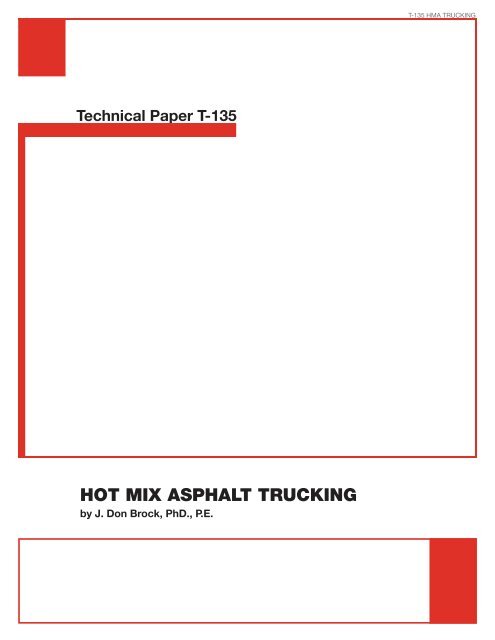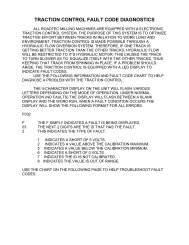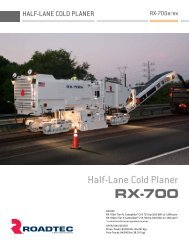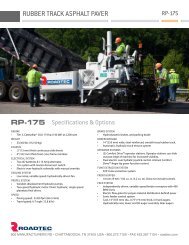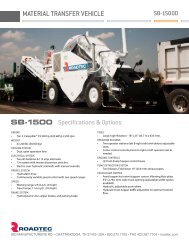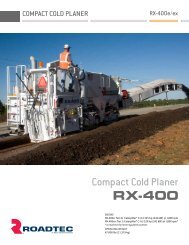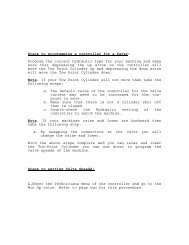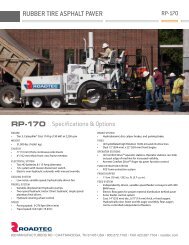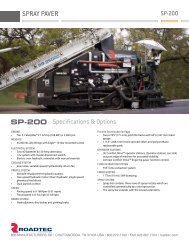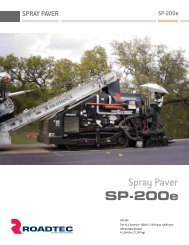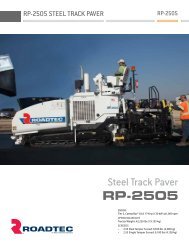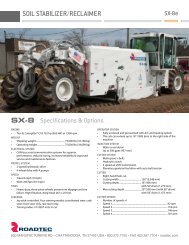You also want an ePaper? Increase the reach of your titles
YUMPU automatically turns print PDFs into web optimized ePapers that Google loves.
T-135 HMA <strong>TRUCKING</strong>Technical Paper T-135<strong>HOT</strong> <strong>MIX</strong> <strong>ASPHALT</strong> <strong>TRUCKING</strong>by J. Don Brock, PhD., P.E.
CONTENTSINTRODUCTION ................................................................................... 4DELAY AT THE PLANT ......................................................................... 6LOADING TIME ..................................................................................... 6SURGE VERSUS STORAGE ................................................................. 9TICKET, TARP AND SAMPLE ............................................................. 12DELAY AT THE JOBSITE .................................................................... 12CONCLUSION ..................................................................................... 173
20 MIN.RETURN15 MIN.DELAY15 MIN.WAITTRUCK CYCLE DIAGRAMMANUAL SPRAY STATION8000#BATCHPLANT5 MIN.LOADING5 MIN.DUMP PAVER ROLLER5 MIN.TICKET & TARPROLLER20 MIN.HAUL TO JOBROLLERINTRODUCTIONThe hot mix asphalt producer is facedwith four separate cost categories inmixing, hauling, and placing hot mixon the road. These cost categoriesare as follows:• Material Cost• Plant Processing Cost• Trucking Cost• Paving CostToday, the highest of these costs ismaterial cost. The second highest isF1 trucking cost. Considerable attentionhas been paid to plant cost andpaving crew costs over the past fewyears. These costs have been reduced substantially by increased productioncapacity of hot mix production facilities and increased yearly throughput at thefacilities. However, less effort has gone into trucking cost reduction becausetrucks are often rented and their cost seems difficult to control. Often, rentalrates are charged by the ton/mile and producers mistakenly assume that thecost is totally controlled by the trucker. In many companies, no attention is paidto trucking cost containment. Over the past few years, trucking costs, like manyother costs, have escalated for the following reasons:• <strong>Inc</strong>reases in cost of equipment• Substantial increases in fuel costs• Shortages of drivers• <strong>Inc</strong>reased driver labor rates• Higher insurance costs• Additional regulations related to drivers’ hours, etc.In addition to these rising costs, another difficulty impacting United States hotmix producers is the severe shortage of qualified drivers and of trucks in manyareas. These factors have led to a new emphasis on better management oftrucking fleets in an effort to achieve better truck utilization and higher efficiency.TRUCK CYCLESA diagram of a typical batch plant operation of the 1970s/1980s era is shownin Figure 1. Usually, three trucks would be waiting in line at such a plant. Often,in the morning, as many as 20 trucks would be lined up, waiting for load-out. Inthe afternoon, when business slowed for the day, the facility would be stoppedand started frequently, with restarts usually not taking place until at least 2-3trucks were in line. Likewise, 2-4 full trucks would often be waiting in line at thepaver, resulting in substantial delays in trucking at both the hot mix facility and4
the paver.Perhaps the best way to understanda trucking operation is to ride in thetruck or to drive the truck throughthe truck cycle and see the variousplaces where the truck is required tostop. Figure 2 lists the componentsof a typical truck cycle. The missionof the truck is to haul mix from pointA to point B. Anytime the truck is notmoving, inefficiencies occur in theoperation. Note that six of the eightsteps shown in Figure 2 are related tonon-movement of the truck. Addingup the time required for each of theeight events results in the total timerequired to complete one truck cycle.Trucking costs today usually rangefrom $40-$50 per hour. By calculatingthe truck cycle time in minutes andmultiplying the minutes by the truckingcost per minute, the trucking costper cycle can be calculated. Dividingthis cost per cycle by the tons ofmix the truck is hauling results in thetrucking cost per ton of mix. Figure3 shows a truck cycle for the operationillustrated in Figure 1. As can beseen in Figure 3, a total time of 85minutes is required to complete onetruck cycle. At $45 per hour (or $0.75per minute), the trucking cost for thecycle is $63.75. Assuming that thetrucks carry 20 tons of mix, a truckingcost of $3.19 per ton results ($63.75divided by 20). If the trucks operate10 hours per day, the number of trips(cycles) each truck can make is foundby dividing 85 minutes per cycle intoITEMS• Delay at the plant• Loading time• Ticket & Tarp• Haul to job• Delay at job• Truck exchange• Dump• Return to plantTRUCK CYCLE ITEMS AND CALCULATIONSTRUCK CYCLE - DIRECT BATCH PLANT LOADINGCALCULATIONS• Cost/cycles...• Cost/ton...• No. of cycles/truck in• No. of cycles required• No. of trucks required• Production: 240 tons per hour = 2,400 tons per day• 20 tons per truck• Truck Cost: $45 per hour = $0.75 per minuteDelay at plantLoading timeTicket, Tarp & SamplingHaul to job (10 miles)Delay at jobTruck exchangeDumpReturn to plantTotal15 min.5 min.5 min.20 min.15 min.2 min.3 min.20 min.85 min.600 available minutes. Therefore, each truck can make 7 trips. If the plant isproducing 2,400 tons of mix per day, and each truck hauls 20 tons, 120 trips willbe required. Dividing the total trips required by the number of trips each truckcan complete in ten hours shows that a total number of 17 trucks is required.At an hourly rate of $45, each truck costs $0.75 per minute, regardless of whetheror not the truck is moving. In the example of Figure 3, it takes 40 minutes to haulto the job and return to the plant. Dividing 40 minutes by the total cycle time of85 minutes results in a truck cycle efficiency of only 47%. This example showsthat in order to increase the efficiency of the trucking operation and reduce thecost, each of the non-moving portions of the truck cycle should be addressedand eliminated if at all possible. The following paragraphs discuss the variousways of reducing or eliminating these delays.Cost/cycleCost/tonCycles/truckCycles requiredTrucks requiredEfficiency %hrs.$63.75$3.1971201747F2F35
Mfg. by Cal Technologies - Palmer, MABATCH PLANT - USING TRUCKS AS SURGEF4F5DELAY AT THE PLANTPlant delays consist of the time tooil or spray a truck bed with releaseagent (often as long as five minutes)and the waiting time to be loaded. Inthe past, when hauling hot mix, fuel oilwas used as a release agent to spraydown in the truck bed. Today, ultrahigh-molecular weight bed liners areavailable, which eliminate the use ofrelease agents. These liners generallycost $4,000-$5,000 per truck bed butcan save the substantial amount oftime previously required to spray therelease agent in the truck bed.To apply release agents, a systemsuch as that shown in Figure 4 canbe used. This system utilizes a sensoron the truck bed that automaticallyturns on a spray as the truck passesunderneath a series of nozzles. Notonly is spray time reduced to approximately15 seconds per truckbed, but the release agent is appliedefficiently and with less waste.When higher temperature mixes arehauled and the use of release agentsis inappropriate, a fine sand materialin the one to two millimeter size rangekeeps the mix from adhering to thetruck bed. Cascading approximatelyone pint of this material into the truckbed has successfully prevented themix from sticking.When the producer owns his trucks,it is recommended to install bed linersto totally eliminate release agentdelay.LOADING TIMEIn the past, extra trucks were sometimesbacked up at the plant and usedas surge bins to allow the plant to operatecontinuously (Figure 5). Whentrucks were inexpensive, labor rateswere low, and fuel was cheap, thistype of surge may have been acceptable.However, with today’s costs,FAST LOADING FROM SURGE BINF66
20 MIN.RETURNAUTOMATIC SPRAY STATION8000#BATCHPLANT1 MIN.LOADING5 MIN.DUMP PAVER ROLLER5 MIN.TICKET & TARPROLLERTYPICAL TRUCK CYCLE WITH SURGE BIN - NO PLANT DELAYS• Production: 240 tons per hour = 2,400 tons per day• 21 tons per truck• Truck Cost: $45 per hour = $0.75 per minuteDelay at plantLoading timeTicket, Tarp & SamplingHaul to job (10 miles)Delay at jobTruck exchangeDumpReturn to plantTotalTRUCK CYCLE - NO PLANT DELAYS0 min.1 min.5 min.20 min.15 min.2 min.3 min.20 min.66 min.Cost/cycleCost/tonCycles/truckCycles requiredTrucks requiredEfficiency %20 MIN.HAUL TO JOBROLLER$49.50$2.35911413• Production: 240 tons per hour + 400 tons storage = 2,800 tons per day• 21 tons per truck• Truck Cost: $45 per hour = $0.75 per minuteDelay at plantLoading timeTicket, Tarp & SamplingHaul to job (10 miles)Delay at jobTruck exchangeDumpReturn to plantTotal0 min.1 min.5 min.20 min.15 min.2 min.3 min.20 min.66 min.Cost/cycleCost/tonCycles/truckCycles requiredTrucks requiredEfficiency %61$49.50$2.4791331561F9F10exact tare weight of the truck is knownwhen weigh batchers or back-waysystems are used, a truck can beloaded safely to its legal limit eachround. The truck cycle in Figure 10looks much like the one in Figure 8,but now trucks are loaded with 21tons of mix instead of 20. The numberof minutes in the cycle is exactlythe same and the cycle efficiency isexactly the same. But, the truckingcost per ton is reduced from $2.47to $2.35 because 21 tons are beinghauled for the same cost as 20 tons.If the plant continues to produce2,400 tons/day, only 114 trips arerequired and, therefore, 13 truckscan be used instead of 14. A slightincrease in the payload of the truckscan reduce the number of trips andresult in substantial savings.There is heavy demand for trucks,resulting in frequent shortages. Thismakes some producers reluctant torelease trucks once they have no usefor them. It is therefore not uncommonto see a surge or storage bininstalled at a hot mix facility withouta corresponding reduction in thenumber of trucks in the truck cycle.As Figure 10 shows, adding a surgeor storage bin to the plant operationand gross loading the trucks allowsa reduction in the number of trucksfrom 17 to 13. If 17 trucks are lefton the haul and are now cycling in66 minutes instead of 85 minutes,the surge/silo will be empty beforelong and the trucks will be waiting15 minutes under the silo, even with200-400 tons of mix in storage atstart-up in the morning.The truck cycle for a facility thathas increased production from 2,400tons to 2,800 tons by beginning withthe silos full in the morning is shownin Figure 11. The trucking cost perton remains the same and the cycletime remains the same. The numberof trips required increases from 114to 133 and 15 trucks will be needed.If the operator continues to use 17trucks, the silos will be empty inapproximately four hours, and thetrucks will again be waiting in line.TRUCK CYCLE - NO PLANT DELAYSF118
To help balance the number of trucksrequired, surge bins and silos canbe used as truck indicators. Figure12 illustrates this point. If too manytrucks are placed on the haul, thesilo will soon be running empty. If toofew trucks are on the haul, the silowill be full. By noting the mix level inthe silo and increasing or decreasingthe number of trucks as required, theproper number of trucks for the mostefficient utilization can be determined.NOT ENOUGH TRUCKSCORRECT AMOUNT OF TRUCKSTOO MANY TRUCKSSURGE VERSUS STORAGEStorage bins (silos) look and performvery similarly to surge bins. In portableoperations, where the hot mixproducer is producing, trucking, andplacing all the mix, the plant operationcan be controlled and managedvery efficiently with a single surge bin.However, on stationary or permanentplants where multiple mixes are requiredeach day and multiple pavingcrews along with FOB customers aresupplied from the same facility, multiplesilos are often required (Figures13 and 14). This allows the filling ofsilos with different mixes, makingavailable two to five different mixesat any one time.The truck savings that can beachieved with a silo are exactly thesame as those achievable with a surgebin (as described above). However,silos have the following additionaladvantages:• Performs the job of a surge binplus also has storage capability (assuresmix availability).• Allows storage of multiple mixesfor extended periods of time to beused as needed.• Reduces plant crew time.• <strong>Inc</strong>reases plant uptime.• Allows the sale of more FOB mixbecause of better service and mixavailability.Most stationary hot mix plants areextremely busy in the morning andoften unable to meet the demandsof the plant owner’s paving crews asBIN USED AS TRUCK INDICATORF12F13F149
OIL FILLS WELLTO SEAL BINOIL IN RESERVOIRSTORAGE BIN BOTTOM LIQUID SEALGREASE MANIFOLDCLOSEDGREASE SEALOPENSTORAGE BIN TOP GREASE SEALFILTERPUMPF15F16well as of FOB customers. However, inthe afternoon, most asphalt plants assumea stop/start operation becausethere is not enough demand to run thefacility continuously. Often, the plantcrew is forced to stay as late as 6:00to 7:00 o’clock in the evening, waitingfor the paving crew to order the lastload of mix. The use of storage binscan help with these problems.Storage bins (silos) look like surgebins but on closer observation aremore sophisticated and considerablydifferent. They are designed to storemix for an extended period of time.To store mix for an extended periodof time, it must not be exposed tooxygen. The higher the mix temperature,the faster the rate of oxidation.Starting at 200°F, for each 25°F risein temperature, the rate of the reactiondoubles. Mix stored at 350°Fwill oxidize four times as fast as mixstored at 300°F. The reaction doublesfrom 300°F to 325°F and again from325°F to 350°F. Therefore, silos mustbe sealed airtight to prevent the mixfrom being exposed to oxygen in theair. A liquid seal, as shown in Figure15, prevents oxygen from enteringthe storage bin around the gate area.The liquid/oil is pumped into the gatearea each evening when the bin isfilled with mix. The next morning thepump is reversed, sucking the liquidback out of the gate area and allowingthe gate to then be opened. A topgrease seal seals the top of the hotstorage bin (Figure 16). With a liquidseal at the bottom and the grease sealat the top, mix has been successfully stored in silos for up to a week withoutsubstantial changes in the mix. An inert gas system, which pressurizes the siloand forces the oxygen-free gas out of the silo and prevents air from coming in,is another type of silo seal. Mechanical seals have generally not been successfulbecause contamination by hot mix prevents air tight sealing. The simplest andleast expensive method of sealing a silo is to close it like a thermos bottle, andthe liquid seal and grease seal have proven to be the most reliable over the longterm. For more information on oxidation of mix, refer to Astec Technical PaperT-103 titled "Oxidation."Operators often worry about temperature loss, but, with the generally wellinsulatedsilos being built today, only hot oil or electric heat around the coneand gate is necessary if at least 6 inches of insulation is applied to the sidewall10
and top of the bin.Storage is basically insurance.Knowing that the mix can be safelyheld for three days to a week givesthe plant operator confidence to fillthe storage bins every night. Usually,mix can be held in a surge binwithout significant loss of mix qualityif storage time is limited to 12 hours.However, because of the unpredictabilityof weather and various otherfactors that effect the paving operation,operators are generally reluctantto store overnight in a surge bin. Thisleads to the type of operation wherethe plant crew comes to the plant at4:00 AM to 5:00 AM (at least two hoursahead of truck arrivals) in order to fillup the silos and have them full at 6:30to 7:00 AM. To insure the silos areempty in the afternoon, batch plantsare often operated without using thesilos after lunch. As previously noted,this practice results in inefficienciesin the trucking operation and leadsto substantial overtime for the plantcrews. By ending the day with thesilos full and having one person stayto load the last truck, the plant crewis required to work fewer hours, whichnot only reduces overtime cost butalso personnel fatigue.Multiple silos (Figure 17) allow storageof different mixes, making it possibleto run high production throughone silo while also serving customersout of the other silos.Filling the bins at night to be readyfor load-out the next morning (Figure18) substantially increases plant uptime. A recent survey showed that 95% ofplant breakdowns occur first thing in the morning. When the plant is down firstthing in the morning, and 15 trucks are forced to wait for two hours while theplant is being repaired, approximately $1,350 in excess trucking cost is incurred.In addition to this, approximately $600 in paving crew cost results from thetwo-hour breakdown. If silos are full, the plant operator can begin operation asnormal, loading the trucks out of the filled silos. By the time the silos are emptied,hopefully the plant would be back in operation and neither the trucking nor thepaving crew operations would have been adversely affected by the breakdown.Having different kinds of mixes available in multiple silos (Figure 17) means bettercustomer service and mix availability and can lead to increased FOB sales. Manyoperators have a relationship with their customers where the customers call inF17F1811
TR-75TR-75TR-75TR-75ROADTECROADTEC30 ton surge capacity. This machinecan help decrease truck delays atthe job site.The Material Transfer Vehicle feedsthe paver with a conveyor, as shownin Figure 23. As the paver approachesthe Material Transfer Vehicle, it isrefilled before the Material TransferVehicle moves forward to receivethe next truck discharge. An insertcan be installed in the paver, allowingstorage of 15-20 tons of mix inthe paver and providing a combinedpaver and Material Transfer Vehiclestorage capacity of 45-50 tons. Withstorage capacity, the paver can operatecontinuously. When a MaterialTransfer Vehicle is used, trucks canbe stopped 100-200 feet ahead ofthe paver and dump safely withoutmoving. The truck can discharge ata location where there is no dangerof the truck bed hitting power lines,tree limbs, etc.Figure 24 shows the truck cyclethat was illustrated in Figures 3 and8 but takes into account the eliminationof truck delay at the paving site.Remember that truck cycle time wasreduced to 66 minutes with the useof a surge bin at the hot mix facility.By adding a Material Transfer Vehicleto perform as a surge bin on the road(as described above), the truck cycletime is further reduced to 48 minutes.Trucking cost falls to $36.00 per tripand to $1.80 per ton (when hauling 20tons per truck). The trucks now make12 trips instead of 7 in the originalexample. Only 10 trucks are required(versus 17) and the efficiency of thetrucking operation climbs to 82%.With a Material Transfer Vehicle,larger trailers of the type used forhauling aggregate can also be usedfor hauling asphalt because truckscan discharge without moving. Usinglarger trailers means using fewerROLLER 1ROLLER 2PAVERPAVING OPERATION USING TRUCKS AS SURGE BINSROADTECROLLERS PAVER MTVPAVING OPERATIONS USING MTV AS SURGE BIN• Production: 240 tons per hour = 2,400 tons per day• 20 tons per truck; Material Transfer Vehicle used at paving site• Truck Cost: $45 per hour = $0.75 per minuteDelay at plantLoading timeTicket, Tarp & SamplingHaul to job (10 miles)Delay at jobTruck exchangeDumpReturn to plantTotal0 min.1 min.5 min.20 min.0 min.0 min.2 min.20 min.48 min.SB-2500Cost/cycleCost/tonCycles/truckCycles requiredTrucks requiredEfficiency %$36.00$1.80121201082F22F23TRUCK CYCLE - NO PLANT DELAYSF2413
ROADTEC• Production: 240 tons per hour = 2,400 tons per day• 26 tons per truck; Material Transfer Vehicle used at paving site• Truck Cost: $50 per hour = $0.83 per minuteDelay at plantLoading timeTicket, Tarp & SamplingHaul to job (10 miles)Delay at jobTruck exchangeDumpReturn to plantTotalTRUCK CYCLE - NO PLANT DELAYSGRAVITY-FED PAVERWITH PREHEATERNEW OVERLAYMATERIALTRANSFERVEHICLEROADTECSB-25000 min.1 min.5 min.20 min.0 min.0 min.2 min.20 min.48 min.MILLED ROADBED150 TO 200 FT<strong>HOT</strong> <strong>MIX</strong>TRUCKCost/cycleCost/tonCycles/truckCycles requiredTrucks requiredEfficiency %MILLING MACHINE$40.00$1.54TRUCK1292883F25ORIGINAL ROADBEDtrucks and results in additional reductionin the cost of trucking operation(Figure 25). Assuming a truck costof $50 per hour for trailers that haul26 tons, the cost of the haul per tonis reduced to $1.57. With the largerpayload of 26 tons, only 92 trips arenow required and the number oftrucks is reduced from 10 to 8.In order to satisfy public demands,highway officials are designing jobsto minimize user delays. In the closecoupleoperation shown in Figure 26a milling machine operates approximately150 feet ahead of the paver.As the old material is milled out, thesurface is automatically swept andnew mix is placed immediately. Usinghigh strength SMA mixes, traffic canbe turned back to the lane almost directlybehind the pavers. A combinedmilling-paving operation also lendsitself to double-hauling: hauling mixout and hauling milled material backto the plant. When double-hauling,the trucking cost of the return load ofmilled material is generally chargedto the milling operation, eliminatingthis cost from the paving operationtrucking cost. This leads to a significantreduction in the mix haul cost,CLOSE-COUPLE PAVING OPERATIONF26• Production: 240 tons per hour = 2,400 tons per day• 20 tons per truck; Material Transfer Vehicle used at paving site• Truck Cost: $45 per hour = $0.75 per minute; RAP backhaulDelay at plantLoading timeTicket, Tarp & SamplingHaul to job (10 miles)Delay at jobTruck exchangeDumpReturn to plantTotal0 min.1 min.5 min.20 min.0 min.0 min.2 min.0 min.28 min.Cost/cycleCost/tonCycles/truckCycles requiredTrucks required$21.00$1.051212010TRUCK CYCLE - NO PLANT OR PAVING SITE DELAYSF2714
as shown in Figure 27. Assuming$45/hour trucking, the cycle timerelated to the mix haul is reduced to28 minutes and the trucking cost perton is reduced to $1.05 from $1.80shown in Figure 24. Wherever millingand paving operations can becombined, a substantial savings inthe trucking cost of both operationscan be realized.At this writing, <strong>Roadtec</strong> has manufacturedover 300 Material TransferVehicles (Shuttle Buggy ® , Figure28). Essentially all of these machineswere purchased to improve pavementsmoothness or to eliminate segregation.Unfortunately, few of the ShuttleBuggy Material Transfer Vehicleshave been used in a manner wherethey truly shuttle as described. To thesurprise of many of the purchasers ofthese machines, maximum cost savingsoccur on intersection work wherethe Shuttle Buggy is truly used as aMaterial Transfer Vehicle (Figure 29).Truck cycles of typical intersectionpaving operations are shown in Figures30 and 31. When no MaterialTransfer Vehicle is used on the intersectionjob, truck cycle time totals83 minutes and efficiency is only48 percent (Figure 30). With the useF28F29F3015
TR-75• Production: 96 tons per hour = 960 tons per day• 20 tons per truck• Truck Cost: $45 per hour = $0.75 per minuteDelay at plantLoading timeTicket, Tarp & SamplingHaul to job (10 miles)Delay at jobTruck exchangeDumpReturn to plantTotal0 min.1 min.5 min.20 min.30 min.2 min.5 min.20 min.83 min.Cost/cycleCost/tonCycles/truckCycles requiredTrucks requiredEfficiency %TRUCK CYCLE FOR INTERSECTION WORK- NO PLANT DELAYS• Production: 96 tons per hour = 960 tons per day• 20 tons per truck; Material Transfer Vehicle used at paving site• Truck Cost: $45 per hour = $0.75 per minuteDelay at plantLoading timeTicket, Tarp & SamplingHaul to job (10 miles)Delay at jobTruck exchangeDumpReturn to plantTotal0 min.1 min.5 min.20 min.0 min.0 min.2 min.20 min.48 min.Cost/cycleCost/tonCycles/truckCycles requiredTrucks requiredEfficiency %TRUCK CYCLE FOR INTERSECTION WORK - NO PLANT DELAYS$62.25$3.11748748$36.00$1.801248483F30F31of a Material Transfer Vehicle, truckcycle times for the same intersectionjob fall to 48 minutes and efficiencyincreases to 83 percent. Using theMaterial Transfer Vehicle substantiallyreduces the paving cost because thetruck can dump and eliminate thedelays that occur in the very slowpaving operation. One contractorreported that with the use of theShuttle Buggy on intersection work,he was able to reduce the number oftrucks from 7 to 3 while doubling thenumber of intersections completedin a workday. Contractors doingcommercial work, such as parkinglots, cul-de-sacs, etc., tell of similarsavings achieved with the use of theShuttle Buggy. While the machineshave been purchased for other applications,the maximum savings theyprovide are due to the fact that thepaver can separate from the truck, allowinghigher paver maneuverability.A substantial amount of the handworkoften required on commercial jobs,can then be eliminated because themobile paver can perform more ofthe laydown operations mechanically.In addition to reducing trucking cost,the Material Transfer Vehicle leads togreat improvements in smoothnesson most paving jobs, reducing ridenumbers from 30” per mile to below10” per mile when using the Maysmeter and similar reductions whenROADTECSB-2500ROADTECROLLERUsed only forfinal sealingof mixPAVER WITHHIGH DENSITYSCREEDMTVCONTINUOUS PAVING PRODUCES SMOOTHER ROADSF3216
using different types of profilographs(Figure 32). The Material TransferVehicle also allows offset pavingwhen shoulders or additional lanesare added (Figure 33). This results insignificant truck savings since trucksare not required to drop down intothe new lane and then pull back outinto traffic (Figure 34). On pavingprojects requiring string lines on bothsides of the paver, such as airports,use of a Material Transfer Vehicle canalso generate considerable savings.One contractor reported that he increasedhis laydown operation from1,000 tons per day without a MaterialTransfer Vehicle to 2,000 tons with thesame number of trucks and a ShuttleBuggy. String lines do not have tobe broken and trucks do not have toback through tack because the truckscan discharge in the adjacent lanewith the Material Transfer Vehicle’sability to transfer material over thestring lines (Figure 35). When pavinghigh-banked race tracks, the ShuttleBuggy can be used as shown in Figure36, making the job considerablyeasier to complete.Figure 37 shows a bottom dumptrailer. Using this type of trailer, mixcan be dumped in windrows. Thewindrow acts as a large surge bin onthe road. While various problems canoccur due to uneven cooling, etc.,MTVSHOULDERMTV ALLOWS PAVERS ON SHOULDER AREAPAVERSHOULDERF33MTVSHOULDERPAVERMTV KEEPS TRUCKS OUT OF NEW LANEF34PAVERMTVTRUCKMTV FEEDS PAVER OVER STRING LINESF3517
MTVPAVERthis method has been used quitesuccessfully in the western part ofthe United States. Pickup machines(Figure 38) pick the windrow materialup and feed it into the paver. Anew version of the Material TransferVehicle has been developed to includean auger and screed on therear and a windrow pickup head onthe front. This new machine can pickup the windrow material, store it,remix it, and place it directly on thepavement (Figure 39). This solvesthe temperature-differential problemoften encountered in windrow paving.PAVING HIGH BANKED RACE TRACK WITH MTVF36F37CONCLUSIONManaging trucks is perhaps the mostdifficult part of the paving operation.Surge bins, storage bins and MaterialTransfer Vehicles allow quick loadingand quick discharging of the trucksand reduce delays at the plant andthe paving operation, thereby improvingthe efficiency of the truck cycle.These devices, along with othersmentioned above, reduce the cycletime and allow trucks to make moretrips in one day. While surge bins,storage bins, and Material TransferVehicles add equipment cost to theentire operation, the offset in the trucksavings will more than pay for thesedevices. Also, demand for truck drivers,which are currently in very shortsupply, will be reduced. The numberof trucks required will be reduced,as will insurance costs, and otheroperating costs related to trucking.In conclusion, to minimize the truckingcost and manage the trucksproperly, the following should bepracticed:• Use the maximum size truck available.• Eliminate all possible delays at plant18
and job site.• Double-haul whenever possible.• Do not over-truck (at $45/hr, one trucktoo many costs $450/day). Calculate thetruck cycle and set the proper amount oftrucks for the particular haul.• Haul distances often vary from day today as the job progresses. Try to find analternate use for trucks when they arenot needed on the short end of the job.• Set an achievable production rate.Determine whether limitations are inplant production, laydown production, oravailability of trucks. Know the limitationsin production and determine theexact number of trucks required for thehaul and do not over-truck.Managing trucks to maximize theoperation as outlined above is one ofthe most challenging tasks in runninga hot mix operation. It is hoped thatthe preceding thoughts and ideaswill assist in managing the problemsrelated to trucking.F38F3919
ASTEC encourages its engineers and executives to author articles that will beof value to members of the hot mix asphalt (HMA) industry. The company alsosponsors independent research when appropriate and has coordinated jointauthorship between industry competitors. Information is disbursed to any interestedparty in the form of technical papers. The purpose of the technical papersis to make information available within the HMA industry in order to contributeto the continued improvement process that will benefit the industry.
ASTEC a subsidiary of Astec Industries, <strong>Inc</strong>.PO BOX 72787 • 4101 JEROME AVE. • CHATTANOOGA, TN 37407 U.S.A. • 423-867-4210 • FAX 423-867-4636 • www.astecinc.com©Astec 2.5M WMS 1/9898-1025Printed in U.S.A.


